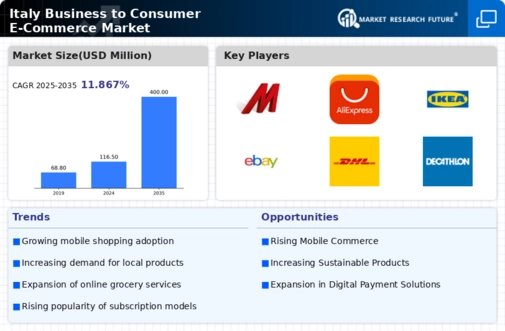Growth of Digital Payment Solutions
The business to-consumer-e-commerce market in Italy is witnessing a notable increase in the adoption of digital payment solutions. As of November 2025, approximately 60% of online transactions are conducted through mobile wallets and contactless payment methods. This shift is largely driven by consumer demand for convenience and security in financial transactions. The rise of fintech companies has also contributed to this trend, offering innovative payment solutions that cater to the preferences of tech-savvy consumers. Additionally, the Italian government has been promoting cashless transactions to enhance economic efficiency, which further supports the growth of digital payment systems. This evolution in payment methods is likely to enhance consumer confidence and encourage more frequent online purchases.
Technological Advancements in E-commerce
The business to-consumer-e-commerce market in Italy is experiencing a surge in technological advancements. These advancements are reshaping consumer interactions. Innovations such as artificial intelligence and machine learning are enhancing customer experiences by providing personalized recommendations and improving search functionalities. In 2025, it is estimated that 70% of Italian consumers will prefer platforms that utilize advanced technologies for a seamless shopping experience. Furthermore, the integration of augmented reality (AR) is allowing customers to visualize products in their own environment before making a purchase, thereby increasing conversion rates. This technological evolution not only streamlines operations for businesses but also fosters a more engaging shopping environment, which is crucial for retaining customers in a competitive market.
Expansion of Logistics and Delivery Services
The business to-consumer-e-commerce market in Italy is significantly influenced by the expansion of logistics. Delivery services are also a key factor. In recent years, the demand for faster and more reliable delivery options has surged, with 75% of consumers indicating that delivery speed is a critical factor in their purchasing decisions. Companies are increasingly investing in logistics infrastructure, including last-mile delivery solutions, to meet these expectations. The rise of same-day and next-day delivery services is becoming commonplace, which not only enhances customer satisfaction but also drives repeat purchases. Furthermore, partnerships with local courier services are emerging as a strategic approach to optimize delivery efficiency. This logistical evolution is essential for businesses aiming to thrive in the competitive e-commerce landscape.
Consumer Demand for Diverse Product Offerings
The business to-consumer-e-commerce market in Italy is shaped by consumer demand for diverse product offerings. Italian consumers are seeking a wide range of products, from niche items to mainstream goods, which is prompting e-commerce platforms to expand their inventories. As of November 2025, approximately 65% of online shoppers express a preference for platforms that provide a variety of brands and product categories. This trend is particularly evident in sectors such as fashion, electronics, and home goods, where consumers are looking for unique and high-quality options. E-commerce businesses are responding by curating extensive catalogs and collaborating with various suppliers to meet these evolving preferences. This diversification not only attracts a broader customer base but also enhances the overall shopping experience.
Increasing Internet Penetration and Smartphone Usage
The business to-consumer-e-commerce market in Italy benefits from increasing internet penetration. Smartphone usage among the population is also rising. As of November 2025, over 85% of Italians have access to the internet, with a significant portion utilizing mobile devices for online shopping. This trend is particularly pronounced among younger demographics, who are more inclined to shop via smartphones. The convenience of mobile browsing and purchasing is driving a shift in consumer behavior, leading to higher online sales. Additionally, the proliferation of social media platforms is facilitating product discovery and influencing purchasing decisions. This growing connectivity is likely to further propel the business to-consumer-e-commerce market, as more consumers engage in online shopping.




















Leave a Comment